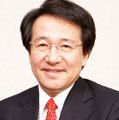
Shigeyuki Yokoyama
RIKEN Structural Biology Laboratory
Title: Structures and functions of seven-transmembrane helix receptors
Biography
Biography: Shigeyuki Yokoyama
Abstract
The adiponectin receptors, AdipoR1 and AdipoR2, are key anti-diabetic molecules. AdipoR1 and AdipoR2 are seven transmembrane helix receptor proteins orienting their N- and C-termini on the intracellular and extracellular sides, respectively, which is opposite to G-protein coupled receptors (GPCRs). We determined the crystal structures of human AdipoR1 and AdipoR2, and found that they represent a novel class of receptor structure. The seven transmembrane helices form a large internal cavity, in which three conserved His residues coordinate a zinc ion. This zinc-coordinated structure indicates that AdipoR1 and AdipoR2 are hydrolytic enzymes. Both AdipoR1 and AdipoR2 assume the closed and open forms. The lipids bound in the closed and open forms were identified, which indicated that the zinc-coordinated structure is for lipid hydrolysis.
We determined the crystal structure of a GPCR, leukotriene B4 (LTB4) receptor BLT1, bound with an antagonist. BLT1 exhibits the canonical seven transmembrane helix structure. The binding mode of the antagonist is characteristic, and is expected to be useful for further drug development.
We applied the cell-free protein synthesis method to production of GPCRs. By adding a mixture of mammalian lipids in the cell-free reaction, GPCRs were synthesized and folded with lipids. This method is useful for large-scale production of high quality GPCR samples for structural and functional studies.
References:
- Muramatsu T, Takemoto C, Kim YT, Wang H, Nishii W, Terada T, Shirouzu M, Yokoyama S (2016) SARS-CoV 3CL protease cleaves its C-terminal autoprocessing site by novel subsite cooperativity. Proc. Natl. Acad. Sci. 113(46):12997-13002.
- Shinoda T, Shinya N, Ito K, Ohsawa N, Terada T, Hirata K et. al. (2016) Structural basis for disruption of claudin assembly in tight junctions by an enterotoxin. Sci. Rep. 6:33632.
- Shinoda T, Shinya N, Ito K, Ishizuka-Katsura Y, Ohsawa N et. al. (2016) Cell-free methods to produce structurally intact mammalian membrane proteins. Sci. Rep. 6.
- Kashiwagi K, Takahashi M, Nishimoto M, Hiyama TB, Higo T et. al. (2016) Crystal structure of eukaryotic translation initiation factor 2B. Nature. 531(7592):122-125.
5. Tanabe H, Fujii Y, Okada-Iwabu M, Iwabu M, Nakamura Y et. al. (2015) Crystal structures of the human adiponectin receptors. Nature. 520(7547): 312-316.
